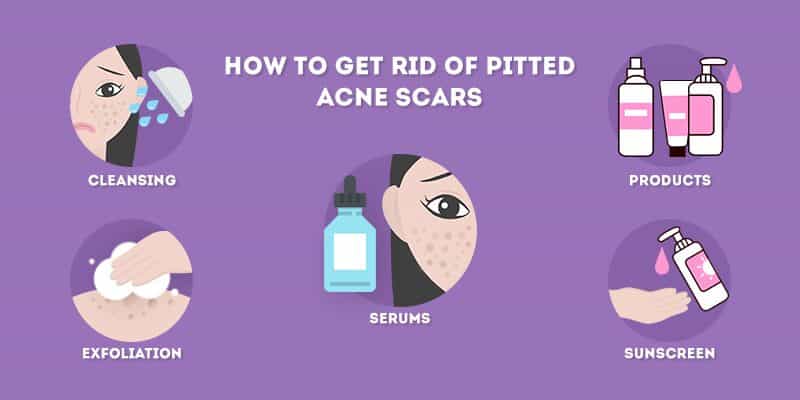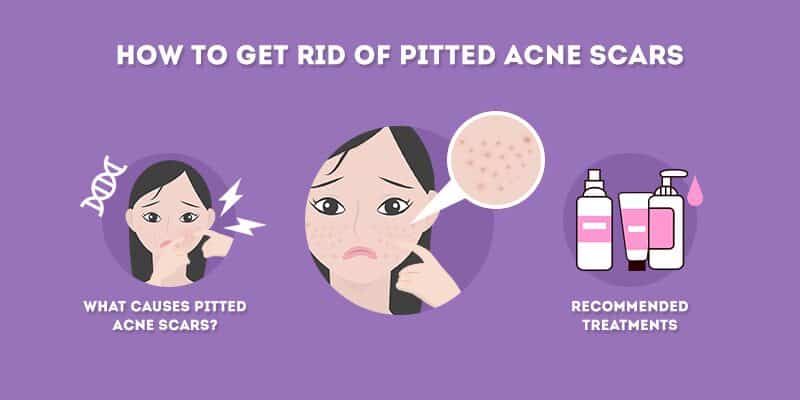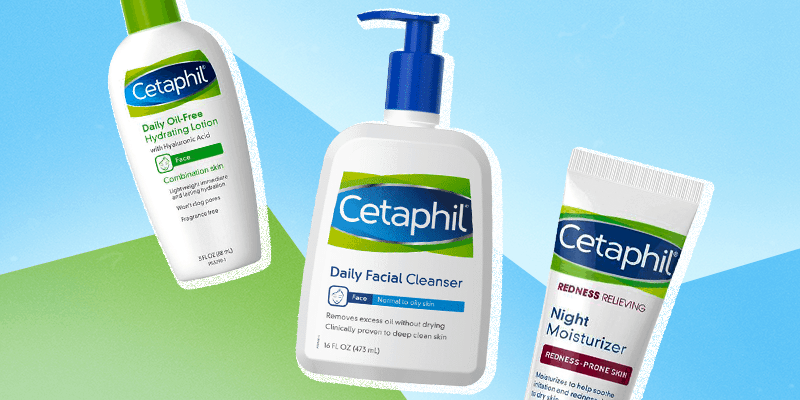Getting rid of pitted acne scars is one of the biggest challenges in dermatology. Unlike superficial scarring and skin discoloration, atrophic acne scars are usually permanent if left untreated. Fortunately, there is hope for those people looking to reduce the appearance of severe scarring. Read on for more information about what options you have in dealing with this type of acne aftereffects.
What Are Pitted Acne Scars?
Acne scars are divided into two categories: atrophic and hypertrophic.
- Atrophic Scars (Pitted Acne Scars) - Atrophic scars are usually the result of severe acne, or even chickenpox. They are indented scarring that heals below the normal layer of skin tissue. They occur when the skin is unable to regenerate tissue, ultimately leaving behind a pitted appearance.
- Hypertrophic Scars - Unlike atrophic scars, hypertropbic scars develop as a result of an overproduction of collagen.
Types of Pitted Acne Scars

The three types of pitted acne scars are: rolling, boxcar and ice pick
Pitted acne scars (atrophic scarring) consist of three different types:
- Rolling Scars: Rollings scars are known for the wavy indentations that scroll across the skin. These scars occur when fibers of tissue form between the upper layers of skin and the tissue located below the surface. As the tissue continues to grow, it pulls on the top layers of skin. This continual stretching then creates the rolling appearance.
- Boxcar Scars: Distinguished by their oval appearance, these depressions are typically marked by their width and uneven characteristics. Boxcar scars are caused by skin inflammation that lowers the collagen levels of the skin. Without collagen, critical rebuilding tissue is lost and the scars begin to take shape.
- Ice Park Scars: One of the most common and difficult to treat of the permanent acne scars, ice pick scars are marked by the resemblance the scar has to a skinny and lengthy ice pick. This type of scarring happens when cysts or infections take hold on the skin. The scar begins to make its appearance as the tissue of the skin is not able to regenerate.
What Causes Pitted Acne Scars?
Pitted acne scars are caused by severe acne. As the most common type of acne scarring, they are a result of the inability to regenerate tissue.
Severe acne flare-ups that continue over time will increase the chances that this scarring takes hold.
Thus, the best way to prevent acne scarring is to actually prevent acne from occurring in the first place.
How to Get Rid of Pitted Acne Scars (At Home)

Here's how you can get rid of your pitted acne scars at home
Although there are no miracle cures when attempting to get rid of pitted acne scars, there are a number of steps that you can take to help the fight against severe scarring.
1. Cleansing
The best thing that you can do for your face is to adopt a regular cleansing routine. Drugstore facial cleansers that formulated for the face will be the best line of defense in the fight against acne.
2. Exfoliation
Although many people neglect the exfoliating process, this treatment can pay big dividends when looking to prevent acne scars from forming. By working to reduce the chances of acne flare-up, acne scarring will also be reduced. The most effective exfoliating products contain either alpha hydroxy acids (AHAs) or beta hydroxy acids (BHAs).
While both types of acid groups are effective at peeling away dead layers of skin, their unique properties make them suited for different types of skin.
- Oil-soluble BHAs, also known as salicylic acid, are better for oily and acne prone skin.
- Conversely, water-soluble AHAs, also known as glycolic or lactic acids, are better suited for use on skin that is not prone to acne because of its ability to smooth out skin tone.
3. Vitamin C Serums
Ava Shamban, MD, a Beverly Hills dermatologist and founder of SKINxFIVE, recommends using a vitamin C serum for acne scars to help brighten the appearance of discoloration. "Vitamin C, especially combined with other antioxidants, will stimulate collagen to help lift up depressed acne scars," she says.
4. Topical Retinoids
Topical retinoids such as tazarotene have been proven to be an effective treatment in the battle to minimize the appearance of deep acne scars. As a derivative of vitamin A, the antioxidant properties in topical retinoids heal damaged skin and promote the production of new skin cells. They are also an exceptional preventative measure to guard against new breakouts.
4. Microneedling/Dermarolling
This innovative process uses hundreds or thousands of tiny needles rolled and inserted into the skin through the use of a specially designed rolling mechanism. According to Healthline, the device promotes the production of both elastin and collagen to stimulate scar relief. Although this process may seem intimidating to beginners, the procedure is actually considered to be minimally invasive while carrying very few risks and side effects. For more severe scarring issues, longers needles should be used in order to provide the most effective penetration and results.
5. Wear Sunscreen
There is a myriad of uses for practicing good sunscreen habits. In addition to guarding against signs of aging, regular sunscreen use can also help to minimize the appearance of existing acne scars. Without the use of sunscreen, even the smallest healing wounds or scars can appear noticeably darker in color when exposed to the sun's harmful UV rays. Be sure to make the regular use of a board-spectrum sunscreen of at least 30 SPF or higher part of your normal skincare routine. Check out our list of best sunscreens to prevent tanning.
Best Products for Pitted Acne Scars
1. Prosper Beauty Dermaroll

Prosper Beauty Dermaroll is an excellent option and great first step in getting rid of pitted acne scars. Follow the directions on the box for best results.
- How to use:For best results use light pressure, gently roll over skin in horizontal, vertical, and diagonal directions. Pass each area of the skin 2-3 times per direction. Do not roll over the same section more than 10 times.
- How it works on pitted acne scars: Microneedling facilitates exfoliation, improves skin’s appearance with a luminous look and gives skin a smoother feel.
- What you can expect: Because everyone's skin is unique and scars may be different depths, it's hard to say exactly. Generally, you should see improvement within 4-6 weeks. For best results, follow up with a vitamin C serum.
2. Mad Hippie Vitamin C Serum

Vitamin C serum is a holy grail in the skincare industry. Vitamin C is potent antioxidant that helps reduce skin inflammation, hyper-pigmentation pigmentation, and promotes healthy collagen production.
- How to use: The powerful antioxidant properties of vitamin C make it a natural option for the treatment of deep scarring issues. Overtime, this potent product will help to improve the skin's appearance and overall tone. Apply twice daily (after cleansing and before moisturizing).
- How Vitamin C helps pitted acne scars: Vitamin C, especially combined with other antioxidants, will stimulate collagen to help lift up depressed acne scars (according to Ava Shamban, MD).
- What you can expect: The formula boasts a unique combination of L-ascorbic acid, vitamin E, ferulic acid, hyaluronic acid, and konjac root. Together, the ingredients work to deliver protection from free radicals while helping the appearance of pitted acne scars. You should see improvement within 4-6 weeks (or longer depending on skin appearance).
3. Paula's Choice SKIN PERFECTING 8% AHA Gel

Paula's Choice 8% AHA gel is well known in the skincare industry - and for good reason. It is an ideal exfoliant for those dealing with hyperpigmentation or skin texture concerns.
- How it use: This leave-on exfoliant will not treat scars but will work to keep acne from forming in the first place. Apply at night after cleansing your skin, and before moisturizing. Leave on, do NOT wash off.
- How AHA helps pitted acne scars: AHAs help pitted acne scars by exfoliating away dead skin cells and helping improve celluar turnover. In addition to helping acne scars, they also help prevent existing acne (ultimately preventing new scars from forming).
- What you can expect: The concentrated eight percent AHA formula uses glycolic acid to slough away dead layers of skin. Additional benefits include the minimization of fine lines and wrinkles and a brighter complexion.
- Ideal for: Those who do not have any existing acne or breakouts
4. Paula's Choice SKIN PERFECTING 2% BHA Liquid Exfoliant

This product is ideal if you're still suffering from acne and trying to get it under control. By controlling your acne, you lessen the chance of new scars from developing.
- How to use: This product can be used after cleansing and before moisturizing. Apply a dime size amount to a cotton ball and apply all over your skin. DO NOT wash off. Follow with your favorite moisturizer.
- How BHA helps pitted acne scars: Specially formulated for acne prone skin, this popular product unclogs pores in an effort to prevent acne from developing. By preventing acne, you also prevent pitted acne scars from developing.
- What you can expect: Although it will not directly reduce scarring, this leave-on exfoliant is a good preventative measure to take to keep acne at bay. Combined with the dermaroller and Vitamin C serum above, you've got yourself a solid plan to finally combating your pitted acne scars.
- Ideal for: Those with oily and acne prone skin.
Professional Treatment for Pitted Acne Scars

For more severe scarring, you should consult with a professional
For most, professionals are the best choice when dealing with pitted acne scars.
1. Chemical Peels
One of the most commonly practiced ways to treat atrophic acne scars is through the use of chemical peels for acne scars. In this procedure, a layer of chemicals is applied to the face and then stripped off. As the mixture is peeled off, dead skin cells are removed and fresh layers of skin are left in its place. This regeneration has proved extremely useful in the fight to decrease the appearance of pitted acne scars.
Chemical peels vary widely in the ingredients used and the strength of the formulation. The most superficial peels will have you back to work in under an hour while stronger peels might even require sedation. This variety makes chemical peels an extremely versatile treatment choice.
2. Fillers
Fillers are a proven treatment when dealing specifically with the scars left behind by rolling atrophic acne. These soft-tissue fillers work by raising the level of the indented scarring to reach the normal layer of the skin, creating a smoother and evener appearance on the surface. The fillers provide immediate results while continuing to improve the plumpness of the skin tissue in an effort to minimize the visible appearance of the scarring.
3. Skin Needling
Also known as microneedling, this process uses a tool with hundreds of small needles to create microscopic punctures on the surface of the skin. These tiny wounds stimulate the production of new collagen. Studies show that by amping up collagen production, skin becomes more elastic and acne scars are minimized.
4. Punch Excision
Studies report that punch excision is very effective in getting rid of acne scars. This treatment uses a small scalpel to punch holes in the skin, cutting out the existing scar tissue. The wound is then closed with stitches and left to heal. Skin is usually taken from behind the ear if a skin graft is needed to close the wound. Although this procedure creates a new scar, it is less obtrusive than the acne scar that had been in its place. Punch excision is an especially popular procedure in the treatment of ice pick scars.
5. Subcision
A subcision is used to describe the process in which a doctor inserts a small needle under the scar tissue in order to loosen the area surrounding the scar.
By doing so, a new wound is created that complements the existing layer of skin. This process then minimizes the appearance of the old scar. Although this procedure can be used as a standalone treatment, it is often combined with other options such as chemical peels and microneedling to provide a more comprehensive treatment regimen.
6. Retin-A (Tretinoin)
As one of the most potent of the group of medications known as topical retinoids, Retin A is a prescription drug used to treat a wide variety of acne and resulting scarring issues. Also known as tretinoin, Retin A can treat existing acne by speeding up the rate of cell turnover and decreasing the buildup of irritants in the pores.
According to Jama facial plastic surgery, topical retinoids are effective as micro-needling for acne scars. Although the drug will not do much to fade severe atrophic acne scars, it can treat the effects of post-inflammatory hyperpigmentation. By working to promote new cell growth, Retin A can also make the skin more toned and smoother in appearance.
When to See a Dermatologist
When over the counter options are not working, it is time to call in the professionals. A dermatologist will determine the most effective treatment protocol.
Take Before and After Pictures
Although it can be uncomfortable to take before pictures, this process is an important part of the documentation. These pictures will help you to understand what is working and what is not. The pictures also provide useful data to the dermatologist overseeing your treatment.
FAQ:
How long does it take for pitted acne scars to fade?
Some scars can take longer to fade than other types of scarring, making it difficult to pinpoint a general time frame. Severe acne scars will never fade away without the help of professional treatments.
Does collagen boosting cream work for pitted acne scars?
Studies show that collagen boosting creams can improve pitted acne scars. However, consult a professional to transform the appearance of severe acne scars.
Can home remedies help with pitted acne scars?
Home remedies may be successful in fading basic discoloration caused by scars. However, natural remedies do not have the strength needed to lift and rejuvenate the skin.
Do acne scar creams work for pitted acne scars?
Some users will find success with specially formulated acne scar creams if the products contain the right ingredients. The best ingredients to look for include vitamin C or other retinoids. These products combined with the microneedling process can improve the appearance of pitted acne scars.





